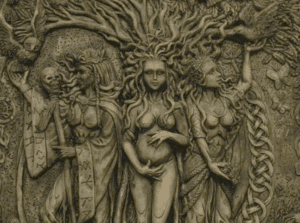The Three Mythical Woman
Lisa Bengiovanni, Mythology & Biography Editor

Three women of mythology at the Tree of Life: The matriarch indicated by the skull, the mother indicated by her gravid condition, and the maiden indicated by the long braided hair.
As far back as time will allow us to see, human cultures have revered women as the strength and teachers of their societies. It’s only in our recent history that the historical role of women has been almost forgotten.
The Maiden, Mother, Crone aspect goes back to the Bolling period ca. 12,500 BC as revealed in translations by Robert Duncan Enzmann in his book Ice Age Language. The Paleolithic Magdalenian culture was a matriarchal society. Here we find that the women did extensive work to keep their families and villages alive and prosperous during the iron cold millennia of the ice ages. They were the ones who kept the children clean, fed, and warm. They made medicine, wove textiles, tailored clothing, and handled the trading for everyone in the community. The grandmothers did the tailoring while teaching the mothers how, the mothers did the weaving and dying of the threads teaching their daughters how, and the daughters collected materials on their distaff, learning to rove the threads for use. This generational teaching process eventually evolved into the Maiden, Mother, Crone (Matriarch), Three Norns, and Triple Goddess mythologies. Hearth-side stories, traded down by the mothers and daughters of generations to teach lessons of survival and time, were told as they spun (this being the origin of spinning a yarn meaning telling a story). This culture carved incredible detail into stone tablets, instructing how, what, and when to hunt specific animals, how to weave blankets and textiles for clothes, how to make shoes, build homes, make tools and weapons, and even how to birth a child. Calendrics were created on stone, bone, and ivory depicting migration patterns, agricultural seasons, and conception times. Enzmann’s research has enabled us to look back on a culture and matriarchal society that showed incredible knowledge and wisdom. His insight and translations give us a glimpse into what it was like to live in an ice age.
The story of three females working together is found in carvings and images all over Europe dating back to 16,000 BC. Doc E states in his translation of the carvings that a female figure with twist signs in her hip identifies her as a spinster – a weaver if you will. Even a 17” relief figure of a female with outstretched arms, found on a rock wall dating to the Gravettian culture ( c. 23,000 BC) in France, bears these markings in her raised horn, with thirteen lines etched in to signify the thirteen months of a lunar year. The spinster who holds up a calendric of the year is showing the fate of time, spinning and weaving the threads of life.
These three ice age women evolved into the story of the Three Norns in Norse mythology weaving the golden threads of fate at the base of Yggdrasil, the Tree of Life. Here we find the maiden Skuld, which translates to What Shall Be, with the mother figure Verdandi, What Is Coming into Being, and the old woman or crone aspect as Urd, meaning What Once Was. Collectively they were known as the Three Goddesses of Fate.
In Greek mythology we learn of the Three Fates: Clotho, who spun the threads of life onto her spindle; Lachesis, who measured the thread of life; and Atropos, who was the cutter of the thread, meaning she determined when death would greet each person. These three wise women controlled the thread of life of every human from birth to death.
We also find a similar story in other cultures. In Roman mythology, the three goddesses named Nona, Decuma and Morta were identified as the Parcae. In Celtic lore the Maiden, Mother and Crone are featured as the three women representing phases of the moon and knowledge. Here the Maiden is expressed as the waxing moon (purity and youthfulness), the Mother represents the full moon (illumination and knowledge), the Crone is symbolized by the waning or dark moon, meaning reflection and purging.
Over the span of time as new civilizations emerged each culture put its spin on the legend, myth, or story or the Fates of Time who spin or weave the threads of life. The names of the three women may have changed but their story the same. They all are connected deep within a past that was centered on women in a culture of the ice age. Their story has been preserved and has come to light, available for all to read and learn, thanks to Dr. Enzmann’s seemingly endless knowledge and research of ice age language, grammar, and vocabulary.
References:
Ice Age Language, Translations, Grammar, Vocabulary. Robert Duncan-Enzmann, J. R. Snyder. 2013.
Iconography of the Fates from the late Middle Ages to the end of the 18th century, Thomas Blisniewski. 1992.
Encyclopedia Britannica, Roman Mythology
Maiden, Mother, Crone The Myth & Reality of the Triple Goddess. D.J. Conway. 2003.
Comparative Civilizations Review No. 51 Fall, 2004. Enzmann/Burgy, Reading Europe’s Paleolithic Writing.





